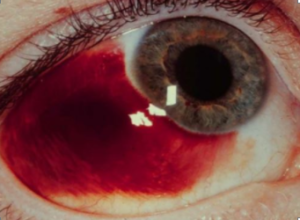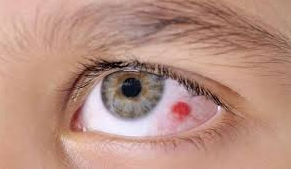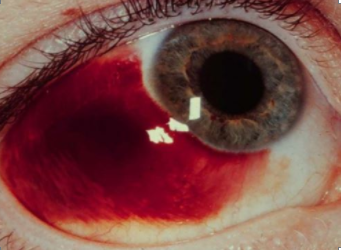Blister on eyeball should call for immediate medical attention. It is impossible to give a proper diagnosis of what the bump might be without have a physical examination by a professional health care provider. A small, white or yellow, fluid-filled bump is most likely to be a cyst of the conjunctiva that forms on the whites of eye. The blisters are common in people who wear contact lenses and those with different types of allergy.

John C. Hagana III, MD, FACS, FAAO, says that this bumps are not serious and will often come and go. The bumps are common and can be very hard to prevent. When a blister, cyst or bump on eyeball gets big enough to feel like they can be drained, it is important to have t checked out by an ophthalmology- an eye medical doctor or a physician.
Here are some of the causes and treatment options for the blisters.
Blood blister on eyeball
An eye blister is a benign growth that appears on the sclera or the whites of the eye or on the cornea. The bump or blister occurring in this parts of the eye can be filled with blood to form what we are calling blood blister on the eye. An eye blister will vary in size, color and other characteristics depending on what the underlying cause of the blister is.
They are two types of blisters that could appear on the eyeball. The blister could either be pingueculae or a pterygium. These two blisters are similar, they are common in older people and people who spent most of their time outdoors without proper eye protection against the UV radiation from the sun.
A common difference between the two blood blisters is that pingueculae are often larger than pterygium and take long to heal. The pterygium, the smaller type of blood blister, is often painless and may come in small lumps of clear lesions.
When left untreated for long, the blisters may become inflamed, red, ad with gritty feeling. The blisters are known to cause eye dryness. Over the counter lubricant, eye drop or artificial tears may be used to relieve the discomfort caused by the occurrence of a blood blister on the eyeball.
Unlike a stye, or a chalazion, blood blister is not very common. They can, however, occur on any part of the eye when they do occur. The actual cause of eye blisters is not understood. It is however believed to be caused by sun damage. That explains why they are common in people who spent a considerable amount of time outdoors without wearing proper UV locking sunglass.
Eye blisters are also believed to occur as a result of an allergic reaction to dust, pollen or chemical allergen that comes in contact with your conjunctiva which is the white of the eyes. The irritation caused by this allergens leads to the damaging in of the thin membrane that lines your causing the formation of the bump that is later on filled with blood to form the painful blood blister on the eyeball.
Though common in older people, anyone regardless of their age can develop an eyeball blister. It is very important to have regular appointments with your health care practitioner, have them examine any bump that appears on your eyeball to rule out the possibility of any serious eye condition.
Blister on eyeball NHS
According to NHS, blister on the eyeball or red eye is often a sign of minor eye condition. Some common cause of red eye or blister would include conjunctivitis or a burst blood vessel. An eyeball blister can be painful signaling a more serious problem. NHS recommends seeking medical attention if the blister or cyst on eyeball fails to clear or improve within a week.
Conjunctivitis which is the swelling or inflammation of the conjunctiva (the thin layer of tissue covering the eyeball and inner surface of the eyelids) is the common cause of red eye, or the blood filled blister appearing on the eyeball. Conjunctivitis makes the blood vessels to swell, this makes your eyes to appear bloodshot and feel gritty.
When the underlying cause of the blister is the inflammation of the conjunctiva, you are likely to experience other symptoms such as:
- Severe itching inside eyes
- Watery eyes
- Sticky coating of the eyelash
- Painful red eyes
- Reduced vision
- Photophobic or sensitivity to light
- Some may experience severe headaches
Conjunctivitis can be caused by an infection occurring on eyes, an allergic reaction to pollen, dust, and other allergens or an irritation from irritants such as chlorine dust. Treating this kind of blisters depends on what the underlying cause is. At times no treatment is required as the blister or red eye could clear on its own.
To manage the symptoms, however, your doctor may recommend the following:
- You will need to clean your face and eye regularly, getting rid of any crusting or discharge from the eye
- Avoid wearing contact lenses or sunglasses until the condition clears
- To prevent an infectious condition from spreading, you are advised to avoid sharing face towel, pillow, and contact lenses
- Clean your hands and avoid rubbing the eyes
- You may try antibiotic eye drop to help with bacterial infection occurring inside eye
- Artificial tears and lubricating eye drop might help to relieve dry and irritating eyes.
Blister on eyeball WebMD
According to WebMD, a blister on eyeball is most common in people who spent a lot of time outdoors. A small blister on eyeball also called pterygium, also referred to as a surfer’s eye, and is a growth of pink fleshy tissue on the whites of the eye. This blister will often form on the side closest to your nose and grows towards the pupil area.
The blister or growth is not cancerous. It can, however, grow or spread slowly. In extreme case, this bump can cover your pupil causing vision problems. That is why you need to see a professional heath care provider as soon as possible. A blister can occur on one or both of your eyes, when occurring on both eyes, the condition is referred to as bilateral pterygium.
WebMD says that the condition is not serious but could cause annoying symptoms. When left untreated, it could also call for a surgical procedure to get rid of it when it grows out of control. The symptoms shown by the blister or bump on eyeball will vary depending on what the underlying cause of the condition is.
Common causes of these bumps will include the following according to WebMD.
- Over exposure to direct UV light from the sun
- Irritants and allergens such as dust, winds
- Natural dry eyes
Blister on eyeball pictures
Through this article, we have provided some images to help with visual illustrations. The pictures, images provided are only to be used for illustration and not for self-diagnosis. Have a professional health care provider examine the blister to identify what the actual underlying cause of the blister is.


Blister on eyeball causes
A blister on eyeball can form due to a variety of reasons. Some of the common and possible cause of blisters might include the following:
Conjunctivitis
Conjunctivitis is the inflammation of the conjunctiva, the thin mucous membrane that lines the inside of the eye. The inflammation of the whites of eyes caused the eyes to become red. The condition is often painless. It can affect one or both of your eyes.
The inflammation can be caused by an infection, an allergic reaction or a physical agent like infrared or ultraviolet. The treatment for this condition will depend on what the underlying cause of the inflammation is.
In most cases, a simple warm compress applied on the affected eye will help bring down the inflammation. Have a doctor look at the condition as soon as you can. At times the condition may clear on its own, as such, no treatment is required.
Burst blood vessel in eye
Red eyes or blood-filled blister on eyes can also result from straining, coughing or injuring your eyes blood vessels. This can cause a bright red blotch. This is called subconjunctival hemorrhage. Though the condition may appear alarming, it is not, the truth is it will clear on its own within some time.
Iritis
Iritis or uveitis is the painful inflammation of the iris. The inflammation may occur due to an underlying condition or problem with your immune system. With this inflammation, your eyes:
- Becomes red
- Becomes photophobic or sensitive to light
- You may experience a blurred vision
- Severe headache may be experienced
Iritis will often respond well to treatment, steroid medication may help bring down the inflammation
Acute glaucoma
Acute glaucoma is a serious condition marked by sudden increase in pressure inside the eye. Glaucoma may cause your eyes to become very painful and red. Just like iritis, people with glaucoma may experience blurred vision, sensitivity to light, and redness of the eye.
When left untreated, the condition could lead to permanent loss of vision. You are advised to seek immediate medical attention as soon as you notice any symptoms of the eye.
Cornea ulcer
The cornea is the clear outer layer at the front of the eyeball. Ann ulcer occurring on this part of the eye is often caused by a viral or bacterial infection. With this ulcer on eyes, the eyes may become painful, red and sensitive to light.
People who wear contact lenses are likely to have bacterial ulcers grow on their corneal. Those who frequently have cold sore are likely to develop viral ulcers.
Most of the above causes will lead to pain and redness in eyes. This condition is often referred to as red eyes. Red eyes is a sign of possible minor eye infection. When the eye gets too painful, it can mean you have a more serious eye condition. Please seek medical attention as soon as possible.
Blister on eyeball after eye rubbing
Excessive rubbing of your eyes can cause a blister on the whites of the eye. The resulting bump is known as a conjunctival cyst. It is a thin-walled sac that is filled with fluid. The cyst can develop on or under the conjunctiva.
Apart from rubbing your eye, a conjunctival cyst may develop due to other reasons such as infection, inflammation, retention cyst among others. It is important to always keep your hands and face clean. Avoid scratching and rubbing your eyes to reduce the chances of developing this kind of blisters on eyes.
Though harmless, a blister on eyeball can be very painful, annoying and hard to get rid of. Continued rubbing of eyes may also lead to a possible viral or bacterial infection on eyes. When left untreated, the blister could also grow in a large painful bump that requires draining and excision to heal.
Blister on eyeball allergy
By definition, an allergy is a damaging immune response by the body to substances. Eye allergy or allergic conjunctivitis is the most common form of allergy affecting the eye. Most people will develop this kind of reactions when their eyes become allergic to certain allergens.
On the eye, the allergens will trigger the release of histamine. This secretion is what results in symptoms such as:
- Itching
- Redness around eyes
- A feeling of burning sensation inside eyes
- The tearing of the conjunctivae
For most people, allergic conjunctivitis can be seasonal or perennial. Seasonal allergy is more common and is related to exposure to airborne allergens such-such as pollen and molds. The other form of allergy (perennial conjunctivitis) on the other hand is common throughout the year, it is triggered by dust mites, animal dander, and molds.
Blister on eyeball treatment
Treatment for eyeball blister will vary from one person to the other depending on what the underlying cause is. It is very important to have the bump, cyst, lump, spot or blister occurring on eye checked by a professional eye care practitioner look at it as soon as possible.
A blister on eye should not be left untreated for 48 hours. To treat the blister, you will need to clear the underlying cause of the blister. Here are some few tips to help manage the symptoms.
- When the underlying cause of the blister on eyeball is an allergic reaction, your doctor is more likely to prescribe an antihistamine medication
- Steroid and corticosteroiddrugs will be prescribed to try and bring down the inflammation and swelling accompanying a blister inside the eyeball.
- Artificial tears and lubricating eye dropare can be used for dry and irritated eyes
- For bacterial infection around eyes, depending on the extent, an oral or topical antibacterial will be administered.
- If possible, you will be asked to used sunglass or contact lensesto prevent further damage from UV rays.
Water blister in eyeball
Water blister is common on skin. A water blister comprises of blood serum minus clotting agent and blood cells. So yes, a water blister could occur on your conjunctiva, the white of eyes. When our body detects damage to the outer layer of the skin (mucous membrane lining the eye) it sends blood to that particular are too cool and heal the area.
The water trapped inside the blister will act as a protective shield to the wound preventing further damage and harm to the conjunctiva. A water blister n eyeball can be caused by any of the following:
- Friction from rubbing your eyes r wearing contact lenses
- Sunburn for those who spent a considerable amount of time outside, old people and those who do not wear UVV blocking sunglasses
- Medical condition such as chicken pox, herpes,
- Allergic reaction from allergens such as poison ivy, pollen, and dust
A water blister can be removed, but please do not attempt to remove it at home. Have the blister removed by a professional eye care practitioner (ophthalmologist)
Blister on eyeball white
A blister forming on the conjunctiva which is also called the whites of the eye can be caused by a variety of condition. The bump on eyeball white’s ca be caused an allergic reaction, which forms what we call a conjunctival cyst.
The blister could also be caused due to an injury, bursting of the blood vessels inside eyes, retention of fluid on the conjunctival among other causes. When small, the blister can be harmless and painless, when left untreated, it could become painful and dangerous. Have a doctor look at it to avoid all this risk.
Yellow blister on eyeball
A yellow blister on eyeball is most like to be a pingueculae. A pingueculae is a yellow patch that occurs on the white of the eye (conjunctiva). In most cases, this blister will appear closer to the nose. This bump is not a tumor, it is only an alteration of normal tissue that results in the deposit of protein and fat.
This bump does not grow on the cornea. On the white of the eye, it can result in a response to chronic eye irritation or sunlight.
Small clear blister on eyeball
A small blister on eyeball can be a pterygium. Unlike the pingueculae, this is a fleshy growth that invades the cornea. The cornea is the clear front window of the eye. This blister result from the abnormal growth of the conjunctiva on the cornea.
Just like the pingueculae, these bumps are also benign and not cancerous. See your health care provider for diagnosis and treatment of this blisters.
Sources and references:
- http://www.medhelp.org/posts/Eye-Care/Blister-on-my-eye/show/322325
- https://www.aapos.org/terms/conditions/13
- http://www.healtholino.com/bubble-on-eyeball-causes-and-treatment/
- http://abcnews.go.com/Health/EyeHealthResource/eye-symptoms-ignore/story?id=16006004
- https://www.reference.com/health/causes-bubble-form-white-eye-5879ac868c93059e
- http://healthh.com/bump-on-eyeball/
- http://www.nhs.uk/conditions/red-eye/Pages/Introduction.aspx
